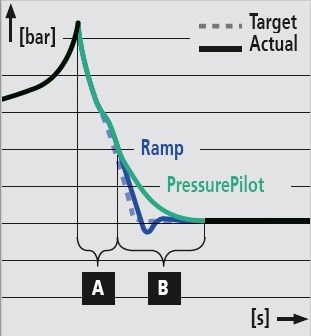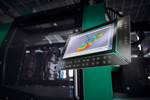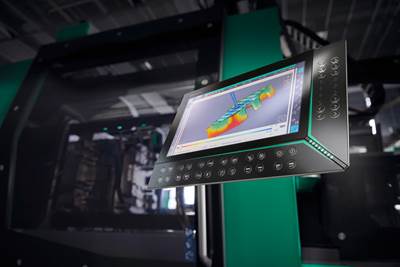Optimized Pressure Control for a More Repeatable Process and Parts
New software from Arburg automatically determines the ideal ramp of the injection-to-hold profile.
Going back to 1987, Arburg’s Allrounder injection molding machines provided a linearly controlled transition from injection pressure to holding pressure using the control’s “switchover via ramps” function. But now, Arburg is taking that capability a step further. With the new aXw Control PressurePilot function for its Gestica control system, Arburg says a non-linear automatically optimized pressure profile is possible, enlarging the process window for molders and providing more balanced fill.
With PressurePilot, the automatically generated curve progression is said to eliminate pressure drops or loss. Pressure is initially reduced abruptly but then ever more slowly. That dynamic and rapid pressure reduction at the beginning helps avoid internal pressure peaks in the cavities, which could lead to overfilling and potential flash formation.
As shown in the accompanying graphic, in the initial, abrupt pressure-reduction (Area A), the older “switchover via ramps” (blue) and PressurePilot (green) curves are basically identical. The differences and advantages of optimized pressure control via PressurePilot function are visible in the final third of the curve (Area B).

Arburg’s aXw Control PressurePilot software automatically smooths out the pressure curve as the injection process switches from fill to hold. The green PressurePilot curve is smoother in Area B than the blue older “switchover via ramps” alogorithm.
Arburg says the benefits are most obvious in multicavity molds, and while it doesn’t position PressurePilot as a replacement for a balanced mold, the software can help solve balancing problems that couldn’t be corrected via mold modifications in a cost-effective manner. Furthermore, filling differences and resulting part-weight discrepancies are further reduced, with short shots and flash formation reliably prevented, Arburg states.
Michael Sansoucy, director of packaging, sales and applications at Arburg, says the technology shares a pedigree with efforts to heighten the precision of screw positioning in hydraulic machines that date back 30 years. “The machine knows that I’m supposed to be at point ‘X’ by time ‘Y’,” Sansoucy says, “and if I’m not there, I need to accelerate. Most machines see the hesitation but would try to speed up, and you lose time—you don’t correct for that missing piece of time.”
In the molding process, when the machine switches from fill to hold and the screw decelerates, there is still the tendency to overshoot the setpoint, Sansoucy explains. With PressurePilot, that overshooting is eliminated, as the screw’s deceleration slope is altered to get it much closer to the setpoint. To overcome that variation in a standard process with a multicavity tool, molders might overpack interior cavities to ensure that outer ones are completely filled. In addition to using more material than is required, this can lead to flash for the central parts and, ultimately, tool damage.
“PressurePilot allows all the cavities to fill at just what you need,” Sansoucy says. “If you’re molding technical parts with a lot of intricate details, you can ensure that everything is filled.” That is, filled but not overfilled. “You have the ability to save material, and even if it’s just a 1/10 of a gram of material, you’re not getting paid for that. If it’s a 96-cavity mold, and 24 of those are overpacked, multiply them by that 1/10 gram. It adds up, and that’s money that as a converter you never get back.” That precision down to a gram comes from the injection unit’s control, which has a scan rate of 0.5 msec, allowing extremely fast adjustments, even on parts with fast fill times.

Arburg foresees utility for the PressurePilot function in multicavity molds where balanced filling can be a challenge.
Related Content
Scaling Up Sustainable Solutions for Fiber Reinforced Composite Materials
Oak Ridge National Laboratory's Sustainable Manufacturing Technologies Group helps industrial partners tackle the sustainability challenges presented by fiber-reinforced composite materials.
Read MoreNew Blown-Film Cooling Technologies Set to Debut at NPE2024
Cooling specialist Addex to roll out new auto-profiling air ring for rotating dies, and new single-plenum air ring.
Read MoreNPE2024 Wrap-Up: Sustainability Dominates Show Floor News
Across all process types, sustainability was a big theme at NPE2024. But there was plenty to see in automation and artificial intelligence as well.
Read MoreBreaking News From NPE2024
Here is a firsthand report of news in injection molding, extrusion, blow molding and recycling not previously covered.
Read MoreRead Next
Arburg Updates Machine Control
Arburg announced a series of updates to its Gestica conrol platform, including the addition of new “assistants” and “pilots.”
Read MoreSee Recyclers Close the Loop on Trade Show Production Scrap at NPE2024
A collaboration between show organizer PLASTICS, recycler CPR and size reduction experts WEIMA and Conair recovered and recycled all production scrap at NPE2024.
Read MorePeople 4.0 – How to Get Buy-In from Your Staff for Industry 4.0 Systems
Implementing a production monitoring system as the foundation of a ‘smart factory’ is about integrating people with new technology as much as it is about integrating machines and computers. Here are tips from a company that has gone through the process.
Read More






















